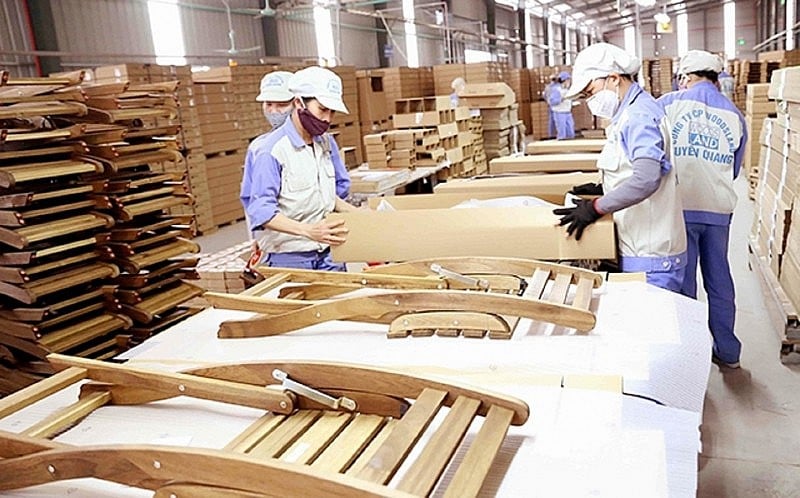| Why did wood and wood products exports to the Dutch market increase sharply in January 2024? The wood industry met to discuss removing difficulties and promoting exports in 2024 |
According to the General Department of Customs, it is estimated that the export turnover of wood and wood products to the Japanese market in February 2024 reached 110 million USD, down 32.5% compared to January 2024 and down 22.7% compared to February 2023. In the first two months of 2024, the export turnover of wood and wood products to the Japanese market is estimated at 273 million USD, up 0.6% over the same period in 2023.
 |
| Timber exports to Japan market increase slightly |
In January 2024, most wood and wood products exported to the Japanese market tended to increase, with wood chips leading the way at 60.2 million USD, up 26.3% compared to December 2023 and up 21.5% compared to January 2023; followed by wooden furniture at 43.7 million USD, up 21.3% compared to December 2023 and up 58.5% compared to January 2023; wood pellets at 36.6 million USD, down 16.3% compared to December 2023, but up 4.2% compared to January 2023...
In the first month of 2024, although the export turnover of wood and wood products to Japan showed signs of improvement, the export situation of wood and wood products to this market in 2024 is forecast to remain unfavorable, as consumer demand in the Japanese market slows down, as the Japanese economy falls into recession in the fourth quarter of 2023.
Japan's gross domestic product (GDP) is expected to contract by 0.4% year-on-year in the fourth quarter of 2023, following a 3.3% decline in the third quarter of 2023. The main reason for the slowdown is weak domestic demand across all sectors, including private consumption. Only external demand, reflected in the value of exports of goods and services, contributed to GDP growth.
Private consumption, which accounts for about half of Japan's economy, fell 0.9% year-on-year in the fourth quarter of 2024 as consumers tightened their belts amid rising prices for food, gasoline and other goods. This was the third consecutive quarter of decline in consumption in Japan.
Weak consumer demand has slowed imports of goods, especially non-essential goods such as wood and wood products, to the Japanese market.
Specifically, for wood chips and wood pellets, import demand in Japan decreased slightly in January 2024. According to statistics from the Japan Customs Agency, imports of HS code 4401 (including wood chips and wood pellets) in January 2024 reached 1.4 million tons, worth 41.1 billion yen (equivalent to 273.1 million USD), down 2.4% in volume and 4.2% in value compared to January 2023.
Of which, Vietnam is the largest supplier of HS code 4401 to Japan, reaching 525.2 thousand tons, worth 13.4 billion Yen (equivalent to 89.2 million USD, down 23.6% in volume and down 32.2% in value compared to January 2023; while sharply reducing imports of wood chips and wood pellets from the number 1 supplier market, Vietnam, Japan has sharply increased imports of this item from the US, Australia, Thailand and Chile markets...
Regarding wooden furniture, according to statistics from the Japan Customs Agency, Japan's imports of this item in January 2024 reached 60 thousand tons, worth 25.6 billion Yen (equivalent to 169.8 million USD), down 6% in volume and 2.1% in value compared to January 2023. In particular, Japan increased imports from the largest supplier market, China, but sharply reduced imports from markets such as Vietnam, Malaysia, Thailand, Indonesia...
Vietnam was the second largest wooden furniture supplier to Japan in January 2024, reaching 12.5 thousand tons, worth 5.2 billion Yen (equivalent to 34.6 million USD), down 20.6% in volume and 13.5% in value compared to January 2023.
In addition to the negative factors, the export of wood and wood products to Japan is also supported, such as wood chips and wood pellets. Japan is focusing on developing many thermal power plants using wood chips and wood pellets. Therefore, this trend of increasing imports is expected to continue in the coming time, opening up new opportunities for the Vietnamese wood industry.
Source





![[Photo] Prime Minister Pham Minh Chinh meets with US business representatives](https://vphoto.vietnam.vn/thumb/1200x675/vietnam/resource/IMAGE/2025/5/13/5bf2bff8977041adab2baf9944e547b5)






























































































Comment (0)